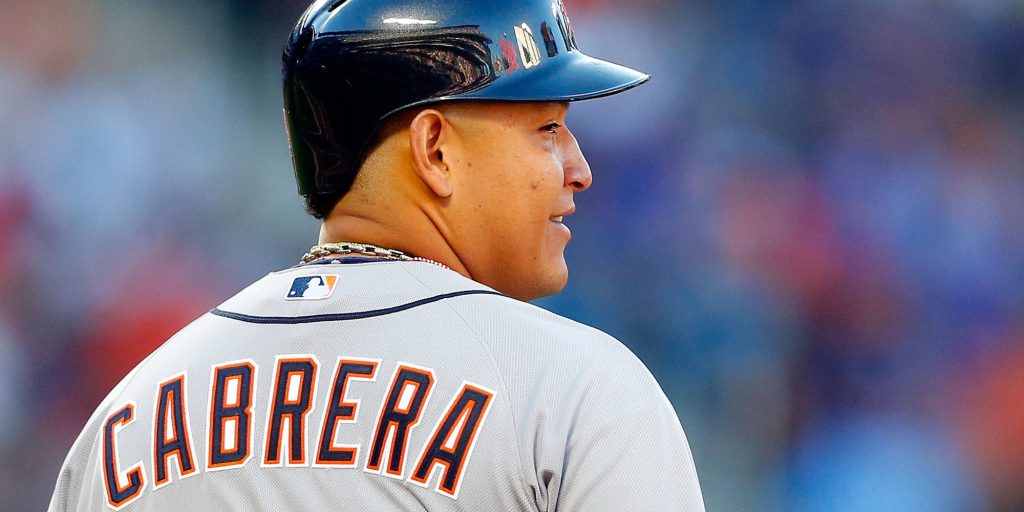Another babka? You’re d*mn right this is another emergency piece!
This is the 62nd installment of The Labyrinthian, a series dedicated to exploring random fields of knowledge in order to give you unordinary theoretical, philosophical, strategic, and/or often rambling guidance on daily fantasy sports. Consult the introductory piece to the series for further explanation.
Digging Through the FanDuel MLB Salaries
Last night, instead of sleeping or doing anything else that I like to do, I was using our free Trends tool to sort through our database of FanDuel salaries for MLB. Since our database goes back to the 2012 season, there’s a lot of material to go through.
#SubtleSpam
Anyways, I spent most of my time looking at batters, their salaries, and the Plus/Minus values and Consistency ratings that accompany those salaries.
As I was sorting through each MLB salary that FanDuel has ever offered for batters — did you know that 100 percent of all $220 players have a -4.20 Plus/Minus?! — I noticed some intriguing macro trends that are worth sharing, especially since it’s likely that similar dynamics can be found at various salary ranges across all DFS platforms and sports.
These macro trends (or observations) follow in no particular order.
The Relationship Between Plus/Minus and Consistency
When I looked at the data for all FanDuel batters from 2012 to yesterday, I found that Plus/Minus and Consistency are correlated, with an r-squared value of 0.54. In other words, 54 percent of the variance that we see in Consistency is explained by Plus/Minus.
On the one hand, you might think that the two factors should have a higher degree of correlation, since Consistency is simply a percentile rating that measures how often a player has at least a +0.00 Plus/Minus.
On the other hand, an r-squared value of 0.54 is pretty high on its own — especially since . . .
- Baseball is an extremely volatile sport.
- Batters are more volatile than pitchers.
- Many factors can impact Consistency.
- Consistency is a yes/no metric on a case-by-case basis, so its lack of gradation doesn’t allow for the data set to recognize that, in any given instance, a -0.01 Plus/Minus is much closer to (and more correlated with) a positive Consistency rating than is a -10.01 Plus/Minus.
Here’s another way of thinking about this: Plus/Minus explains Consistency in MLB DFS more than any other factor or metric does (at least on FanDuel).
What this means is that if you are looking for players with high Consistency then you should probably just look for players with high Plus/Minus values, since in the aggregate Consistency tends to follow Plus/Minus anyway. And vice versa.
The Batter Baselines
Here are the baselines that I found last night when looking at the sample of 179,654 FanDuel batters:
- Plus/Minus (pts): +0.02
- Consistency (%): 38.9
All analysis for the rest of the piece will refer to these baselines.
$220 – $2,400 Batters: Dumpster Divers Get Covered Trash
At each price point within the $220 – $2,400 tier, batters consistently have a subpar Consistency. For every salary except for one ($2,200) they have negative Plus/Minus values. In the aggregate, the Plus/Minus for this tier is decidedly negative.
- Plus/Minus (pts): -0.23
- Consistency (%): 36.9
Here are the differentials when these numbers are compared to the baselines:
- Plus/Minus Differential (pts): -0.25
- Consistency Differential (%): -2.60
Paying down is sometimes necessary, but even if you want to ignore the one random $220 salary and the five $1,500 salaries, what we see from $2,000 to $2,400 is a cohort of players who deserve to be even cheaper than they are. They provide salary relief, but in general they provide neither value nor reliability.
Unless you take the money you save by rostering these players and invest that money in higher-priced players who compensate for the value you’re not getting by paying down, then there’s absolutely no reason (aside from ownership arbitrage) to roster players in this price range.
$2,500 – $3,100 Batters: The Difference Between Inexpensive and Cheap
This tier really intrigues me. In general, these batters aren’t expensive — you can still find salary relief by rostering them — but they, unlike the cheaper batters, won’t destroy your lineups. They (arguably) more than hold their own.
- Plus/Minus (pts): 0.00
- Consistency (%): 41.0
When we look at the differentials, we see that we get some bang for the buck:
- Plus/Minus Differential (pts): -0.02
- Consistency Differential (%): +2.10
In terms of Plus/Minus, this tier is barely negative and the Consistency is incredibly robust. At each price point in this tier, batters surpass the baseline Consistency. Many more of these batters than we might expect meet their salary-based expectations. Of course, the data suggests that the batters in this tier who don’t meet their salary-based expectations really fall short of the mark — but you can’t have everything when you’re paying down.
Based on this data, I believe that if you are going cheap then you shouldn’t go super cheap. You should be a little less frugal and invest in a tier of players who might actually be better than you expect.
$3,200 – $3,900 Batters: Cash-Game Fades, Tournament Plays
This tier is the meat on the bone of the beast that’s MLB DFS at FanDuel. (I don’t even care if that sentence makes sense. You know what I mean.) This tier honestly might be the most intriguing of them all.
- Plus/Minus (pts): +0.16
- Consistency (%): 37.4
Do you see it?
- Plus/Minus Differential (pts): +0.14
- Consistency Differential (%): -1.50
This is fantastic. We’ve reached the first tier with a positive Plus/Minus, but these players — the guys at the center of most lineups — are less consistent than we’d want. At every price point in this tier, the players fail to reach the baseline Consistency of 38.9 percent.
Think about that: Even though they easily exceed expectations, the players who form the core of your cash-game lineups consistently fail to reach the average level of Consistency. What does that mean?
- It means that, as volatile as MLB DFS is, you are making it even more volatile by rostering these players in your cash games.
- It means that these players are ideally suited for guaranteed prize pools — precisely because of their volatility.
In this tier, not as many players as we might expect meet their salary-based expectations, which means that the players who do meet expectations don’t just meet them. They crush them to such an extent that they make the Plus/Minus positive for the entire cohort of relative underperformers.
In general, these guys look like overvalued cash-game plays (especially if you value Consistency), but they fit the tournament archetype perfectly: They are productive and volatile.
$4,000 – $4,900 Batters: The Blue Chips
This tier is about four times smaller than the previous tier and is actually the smallest of all the ‘real’ tiers — the three tiers after this one are ‘unreal’ in that they collectively make up just over one percent of the entire sample population — but it makes sense that this tier is so small: Anything of true value in this world is hard to find and thus costly to acquire.
The irony is that often the truly valuable is somehow undervalued.
- Plus/Minus (pts): +0.20
- Consistency (%): 40.2
Welcome to paradise.
- Plus/Minus Differential (pts): +0.18
- Consistency Differential (%): +1.30
These are the guys you want. They are the blue chips. Cash games, GPPs, whatever. No tier surpasses expectations to such a degree — that +0.18 mark is unrivaled in the sample — and every price point in this tier surpasses baseline Consistency.
These players aren’t quite as consistent as the batters in the $2,500 – $3,100 range, but they are far more productive.
In the next three tiers you can find some valuable players — but . . .
- Batters above $4,900 aren’t especially common.
- You’ll need to find decent cheap players in order to have sufficient salary space to roster a batter who costs more than $4,900.
- You’ll need to avoid the bad batters who cost more than $4,900, because they are more numerous than you might think.
To wit . . .
$5,000 – $5,500 Batters: The Great Recession
This is what it looks when you invest in the market at its peak.
- Plus/Minus (pts): -0.39
- Consistency (%): 36.3
Those numbers are as bad as you think they are.
- Plus/Minus Differential (pts): -0.41
- Consistency Differential (%): -2.60
Five of the six price points in this tier yield both negative Plus/Minus values and sub-baseline Consistency ratings.
Historically, investing in this tier has been the DFS equivalent of giving your entire life savings to Bernie Madoff.
$5,600 – $6,300 Batters: The Crown of Consistency
This tier contains only 329 batters, so it’s dangerous to assume too much based on the results, but . . .
- Plus/Minus (pts): +0.12
- Consistency (%): 42.6
After that last tier, this one is a breath of fresh air.
- Plus/Minus Differential (pts): +0.10
- Consistency Differential (%): +3.70
From price point to price point, there’s a lot of volatility within this tier in terms of Plus/Minus, but every price point in this tier exceeds baseline Consistency.
Players in this tier hardly ever come around. They are very rare. But when you see one in a slate, put him in at least one GPP lineup.
- This tier’s costliness might make him relatively low-owned.
- This tier’s Consistency suggests that he would be relatively unlikely to have a bad performance.
- This tier’s volatility could transform him into a tournament winner.
Only eight times has FanDuel priced a batter at $6,300. In those instances, the batters have delivered a +6.27 Plus/Minus with 62.5 percent Consistency.
Again, I don’t want to make too much of these numbers, but in general these batters have lived up to their salaries, unlike . . .
$6,400 – $6,600 Batters: The Great Depression
This is what it looks when you enter the world on October 29, 1929.
- Plus/Minus (pts): -4.40
- Consistency (%): 28.6
I don’t even know what to say.
- Plus/Minus Differential (pts): -4.42
- Consistency Differential (%): -10.30
Talk about getting screwed with your pants on.
There have been 28 batters in this tier. That’s probably 30 batters too many.
This Article Isn’t Long Enough, Is It?
A few thoughts to send you on your way. These aren’t hard-and-fast rules. If you look hard enough, you can always find a decent batter to roster in any tier, and I’m not telling you not to do that.
I am, though, giving you guidelines so that you can limit the number of times you screw yourself:
- $220 – $2,400: Avoid like the plague.
- $2,500 – $3,100: Roster in cash games.
- $3,200 – $3,900: Roster in GPPs.
- $4,000 – $4,900: Roster everywhere.
- $5,000 – $5,500: Probably avoid everywhere.
- $5,600 – $6,300: Probably roster in GPPs.
- $6,400 – $6,600: Treat like a unicorn: Rare, theoretically cool, and will stab you if you get too close.
At some point in the future, I’ll do a similar exercise for FanDuel pitchers and also all DraftKings batters and pitchers.
Till then, remember not to pay some guy $6,600 to screw you.
———
The Labyrinthian: 2016, 62
Previous installments of The Labyrinthian can be accessed via my author page. If you have suggestions on material I should know about or even write about in a future Labyrinthian, please contact me via email, [email protected], or Twitter @MattFtheOracle.





